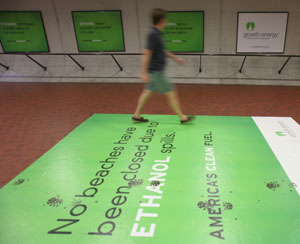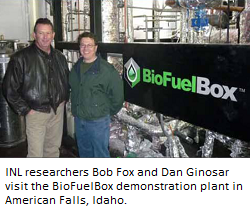Capitol Hill commuters will be hard pressed to miss the message that ethanol is America’s clean fuel as they travel the DC metro system this month.
 Starting at the foot of the escalator with a 10’x12′ floor mat with oil-soaked boot prints and the words “No beaches have been closed due to ETHANOL spills…. America’s CLEAN fuel,” the entire Capitol South Metro stop is saturated with positive ethanol messages from top to bottom.
Starting at the foot of the escalator with a 10’x12′ floor mat with oil-soaked boot prints and the words “No beaches have been closed due to ETHANOL spills…. America’s CLEAN fuel,” the entire Capitol South Metro stop is saturated with positive ethanol messages from top to bottom.
Growth Energy chose the closest stop to the U.S. Capitol, the offices of the House of Representatives, and the headquarters of both the Democratic National Committee and the Republican National Committee as the focus of a month-long advertising “take over” that includes 46 posters, banners, floor graphics, pylon wraps and posters that cover the station. Christopher Thorne, public affairs director for Growth Energy, said the group launched the station domination to increase awareness among top decision-makers of the benefits of domestic ethanol as an alternative to oil.
“For the next month, every person walking through the Capitol South Metro stop will see our message that domestic ethanol is America’s fuel because it is renewable, clean, homegrown, creates U.S. jobs and strengthens our national security,” Thorne said. “As Congress debates energy and climate legislation, we want to make sure that domestic ethanol is part of the conversation. There is no question as to ethanol’s benefits – we are just seeking to turn up the volume and target our audience at a critical time.”
An estimated 423,000 visitors are expected to travel through the Metro station during the month of June. The “take-over” coincides with a six-month, $2.5 million campaign currently airing six television spots on four cable networks: Fox, MSNBC, CNN and HLN (formerly Headline News). Each of the six spots focuses on a particular message about ethanol: Independent, Clean, Renewable, Peace, Sensible and Economic.





 The
The  The study, conducted by Dr. Steffen Mueller at the Energy Resources Center at the university and funded by the
The study, conducted by Dr. Steffen Mueller at the Energy Resources Center at the university and funded by the 



